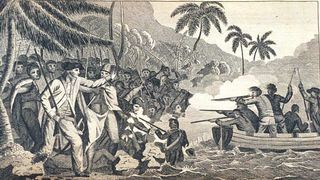How Captain Cook Changed the World

Each Monday, this column turns a page in history to explore the discoveries, events and people that continue to affect the history being made today.
He was a latecomer to the Age of Exploration, but James Cook still managed to put his mark on world history in the final frontier of terra incognita – the Pacific Ocean and its isles.
Cook used the latest scientific methods and techniques of cartography to chart his epic voyages to places such as Tahiti, Australia, New Zealand and Hawaii. Many of his expeditions marked the first time that native inhabitants of those islands had ever seen a Western face.
What few people know is that by the time Cook got around to his well-known Pacific travels, the English seafarer had already played a part in the 1759 capture of Quebec, which ultimately led to the British dominance in North America.
Capturing Quebec City
The United States and Canada, to say nothing of the islands of the Caribbean, might belong to France had it not been for James Cook.
After rising through the ranks of the British Royal Navy in just a few short years, promising navigator James Cook was sent in 1758 on a mission to chart the waters of the Saint Lawrence River in what would become the province of Quebec.
Sign up for the Live Science daily newsletter now
Get the world’s most fascinating discoveries delivered straight to your inbox.
The British had been embroiled in the Seven Years War against the French for years and it was not going well in North America. Using Cook's detailed maps, however, the fleet was able to capture Quebec City, a victory that ultimately led to the end of the war and the transfer of most of the continent from France to Britain.
Mystery continent
In 1768, Cook was made captain of the Endeavour, leading an expedition of scientists and sailors to observe the transit of Venus across the sun, in the sky above Tahiti, an infrequent event that helped astronomers measure the distance between the Earth and the Sun.
That wasn't the only objective of the Royal Navy, however.
A secret, sealed message was also given to the captain — which Cook dutifully opened only after the finishing his observations in Tahiti — instructing him to search for the elusive mammoth continent that European explorers called Terra Australis (or land of the South). Rumors of this major landmass, thought to cover the entire bottom quarter of the globe, had been around since parts of northwestern Australia were charted by Dutch explorers more than 100 years prior. Cook found and explored eastern Australia during his mission, assuming it was not the great expanse they were looking for but a new territory nonetheless, and claimed it for Great Britain.
For the British, the discovery came just in time, as the loss of its American colonies had exacerbated its problem of overcrowded prisons.
The first penal ships left England for Australia a decade after Cook returned with his report, becoming the first non-native settlements there and shaping that nation's history.
Explore to the death
Cook returned to the sea again in 1773, equipped with the latest in navigational tools, on another attempt to solve the mystery of Terra Australis. When the fabled landmass remained unfound, Cook declared the mystery solved — there was no lost continent as the Europeans had hoped. He was, however, the first to suggest the existence of Antarctica, whose cold waters he'd traveled through in search of Terra Australis.
During his second voyage, Cook also mapped much of the South Pacific islands, most of which had never had been visited by non-Polynesians.
Americans who like to relax in the "stateside" playgrounds of Maui or Oahu have Cook's third voyage to thank. This final and fatal journey in search of a Northwest Passage connecting the Pacific to the Atlantic Oceans crossed paths with the Hawaiian Islands, until then unknown to the outside world, in 1778. He died there on a return trip in 1779, stabbed while trying to take a Hawaiian chief hostage.
At his death, Cook had charted thousands of miles of coastline around the world and solved several mysteries of the South Pacific. He did all that and along the way lost only a few men to scurvy, a rampant problem at the time, by encouraging his sailors to eat their fruits and veggies.
Most Popular




